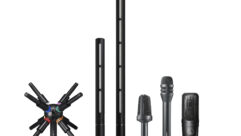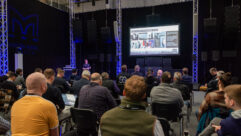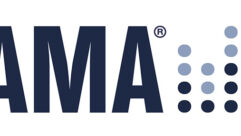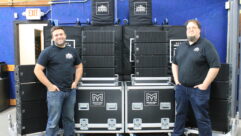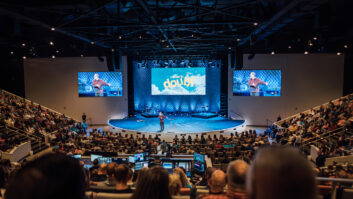LAX Steers Into Clear Audio
Steerable loudspeaker arrays help airport create intelligible paging system.
Credit: Renhus-Heinz
CHALLENGE: Install new paging system in a large, glass-enclosed rotunda that’s fraught with acoustical issues.
SOLUTION: Use pair of digitally controlled line-array loudspeakers that allow for the sound energy to be precisely aimed and calibrated throughout the facility.
“What flight was that?”
That’s been a commonly heard refrain at Los Angeles International Airport’s (LAX) Terminal 3 since the aging facility first geared up for the jet age nearly 50 years ago, as waiting passengers strained to understand voice announcements offering flight information, safety and security advisements, and last-boarding calls.
Indeed, the large, high-ceilinged, hard-floored, glass-enclosed rotunda that houses the busy gates of airlines that include Alaska, American, Frontier, Horizon, and Midwest Express has always been too much of an acoustical challenge for any of the myriad public address systems that have been put into it over the years to overcome.
“It’s one of the older terminals. It hasn’t been remodeled in some time, and it’s a very reverberant space,” notes Bill Schaffer, an engineer for Hawthorne, Calif.–based Direct AV, the integrator charged earlier this year with trying to configure Terminal 3 with a more intelligible public address system. “They’ve had mediocre paging in there for so long, in the ceilings, attached to the tops of sign board, and they all sounded bad.”
Ranked near the bottom of recent J.D. Power and Associates surveys polling flyer satisfaction within large metropolitan airports — 14th out of 17 — LAX has resolved to improve life in its terminals. The airport plans to spend about $60 million dollars over the next 10 years to spruce up these areas, with upgrades such as digital signage and improved public address systems.
POWER STEERING
Line-array loudspeakers have been widely used for decades, but the recent emergence of powerful DSP audio technology has enabled the cylindrical wave fronts generated by these loudspeakers to be individually controlled so that they don’t bounce off of things they shouldn’t.
The glass-enclosed rotunda that is Terminal 3 at Los Angeles International Airport (LAX) — an area fraught with many acoustically reflective surfaces — provides an excellent application of the technology.
Using proprietary 2-D and 3-D prediction software, Renkus-Heinz engineers were able to acoustically map the terminal before installing two Iconyx IC24 steerable line-array loudspeakers. “Basically, we were able to set up a simulation of the room’s acoustical patterns,” explains Jonas Domkus, a Renkus-Heinz applications engineer. “We were then able to create and load specific beam filters into each loudspeaker column.”
With each loudspeaker containing 24 individual transducers that are each controlled by their own digital signal processor, Domkus and his team were able to create specific sets of algorithms for each loudspeaker element so that their outputs could be individually aimed and narrowed.
The process “helps us keep the sound off the hard surfaces as much as possible and direct it to the listeners themselves,” Domkus adds. “The beams are narrow and steerable so that they don’t excite the room as much as a traditional loudspeaker.”
As far as Terminal 3 is concerned, that process started last spring when the airport contracted to Direct AV to upgrade the audio systems in several of its terminals. The integrator had already established a solid “in” with LAX several years ago when it hired Schaffer, who worked for the airport for seven years overseeing camera surveillance and other security systems.
According to Larry Frontino, Direct AV’s president and CEO, the Terminal 3 project started with representatives from a number of top audio equipment manufacturers visiting the airport to demonstrate various loudspeakers. Most of these “just didn’t sound right,” he notes.
The solution arrived when reps for Renkus-Heinz previewed their slim Iconyx IC24 self-powered loudspeakers, which feature 24 transducers and three 8-channel amplifier/DSP processors vertically embedded in a narrow 111.5-inch vertical column. Using advanced software and powerful digital processing, the output from each speaker element can be precisely “steered” so that its digitally-controlled sound waves avoid hitting the myriad reflective areas of the building (see sidebar).
“The Renkus-Heinz people picked a good location for them on an interior wall within the rotunda,” Schaffer adds. “They got them tuned, fired them up, and they worked perfectly. These things are good for about 118 decibels. “They’re loud at distance, but not loud up close. You can stand right in front of it and it won’t hurt you,” he says.
“I was skeptical until I heard it,” Frontino says. “But they delivered really good, balanced audio all throughout the area. They don’t take up a lot of space, and since they mount to the wall, we don’t have to cut into the ceiling and get into an asbestos situation.”
While the Renkus-Heinz speakers provided Direct AV with the tool to solve a key technical issue, getting Terminal 3’s broader audio upgrade underway proved challenging.
Given the financial constraints of the airport (the facility, which processes 60 million passengers a year, could only release funding for such upgrades in $100,000 increments) and the price tag of the loudspeakers — each retailing at around $14,000, according to Schaffer — Direct AV had to build a budget-minded audio system around the twin Iconyx IC24s that could be upgraded later when more funds were released.
“We bid to do the whole terminal, but since they could only offer up $100,000 increments, to start out with, we only had enough money to put in a new audio backbone and address that one problem area, the paging system,” Frontino explains.
Much of that initial budget was consumed by the need to establish an audio mainframe system, which costs about $60,000, according to Frontino.
To create a new head-end facility for the terminal’s audio system, Direct AV annexed a small electrical room about 150 feet from where the speakers had been mounted and installed an IED 500ACS audio processor. Widely used in airports, the device features digital signal processing, microphone stations, and synchronized audio-visual paging.
FOR MORE INFORMATION
- Renkus-Heinzwww.renkus-heinz.com
- Radio Design Labswww.rdlnet.com
- IEDwww.iedaudio.com
- Beldenwww.beldencdt.com
About 10,000 feet of shielded, twisted pair Belden 9402 cable was then used to connect each of the 30 paging stations, located at the gate podiums within the terminal, to the head-end. “Airport officials didn’t want to put conduit in yet,” Schaffer explains. “Luckily, the underneath space, which is a baggage handling and service area, was wide open. We were able to use cable trays and things of that order.” When funding permits, these connections will be upgraded to a combination of CAT-5 cabling and wireless, he adds.
Beyond that, the initial phase of the project was fairly limited — the only notable addition was a Radio Design Labs L IC1 intercom amplifier that was connected in between the IED 500ACS and the two Renkus-Heinz loudspeakers, mainly for the purpose of volume control.
“It’s a very old facility with very old equipment,” Schaffer adds. “We did the best we could with the money that was available.”
For Direct AV, the task of obtaining the LAX bid — and executing the project — has been made much easier by its extensive experience working with the airport, a place that can be difficult for uninitiated AV integrators to navigate their way into and through.
“You have to know how to work at an airport, know what the politics and the rules are,” Schaffer says. “It’s expensive to work at a place like LAX. You need the right badges and access, and you need the right insurance.”
Indeed, an independent contractor needs $5 million in liability coverage just to be able to drive onto the tarmac; at minimum, they need $2 million in liability coverage plus a $100,000 customs bond (cost: $5,000) just to work in peripheral places like Terminal 3, according to Schaffer.
As for the knowledge of such a facility’s inner workings, that can help an integrator like Direct AV roll with the punches when, say, a client like LAX makes a mistake with its project scheduling and commits a wall with new paging speakers on it to a new digital signage system.
Indeed, at the time this article was written, Direct AV was in the process of moving the twin Renkus-Heinz speakers to two columns on the opposite side of the rotunda to make way for the aforementioned signage.
“There’s a race to renovate LAX going on right now, and the city’s engineers and project managers don’t know what the other hand is doing,” Frontino explains. “We’re going to put the loudspeakers in a different area of the terminal, but they will still result in improved speech intelligibility.”
Daniel Frankel is a Los Angeles–based freelance writer. He can be reached at [email protected].


